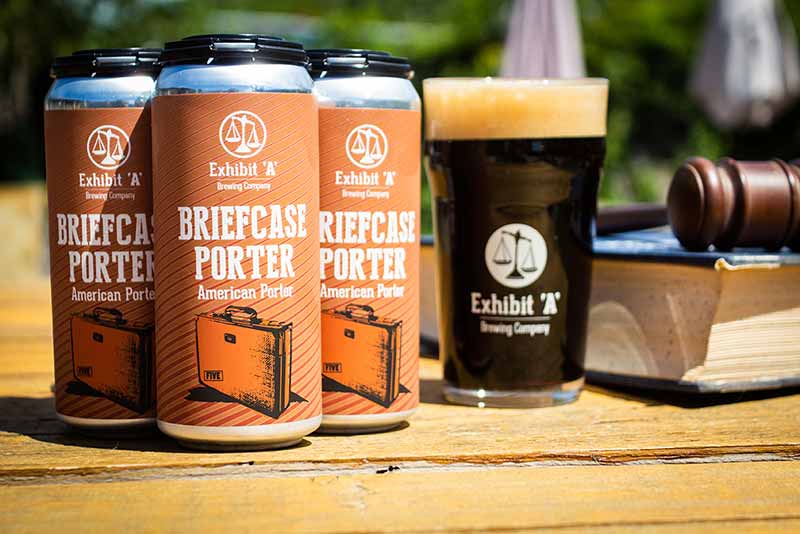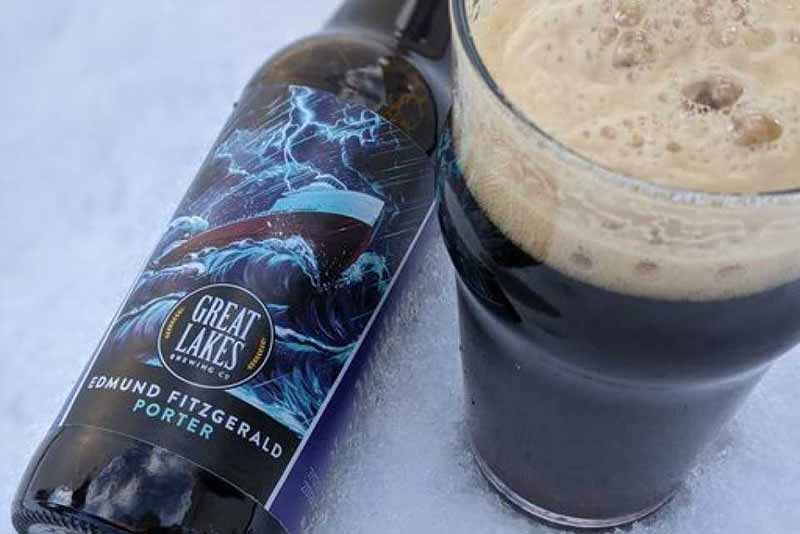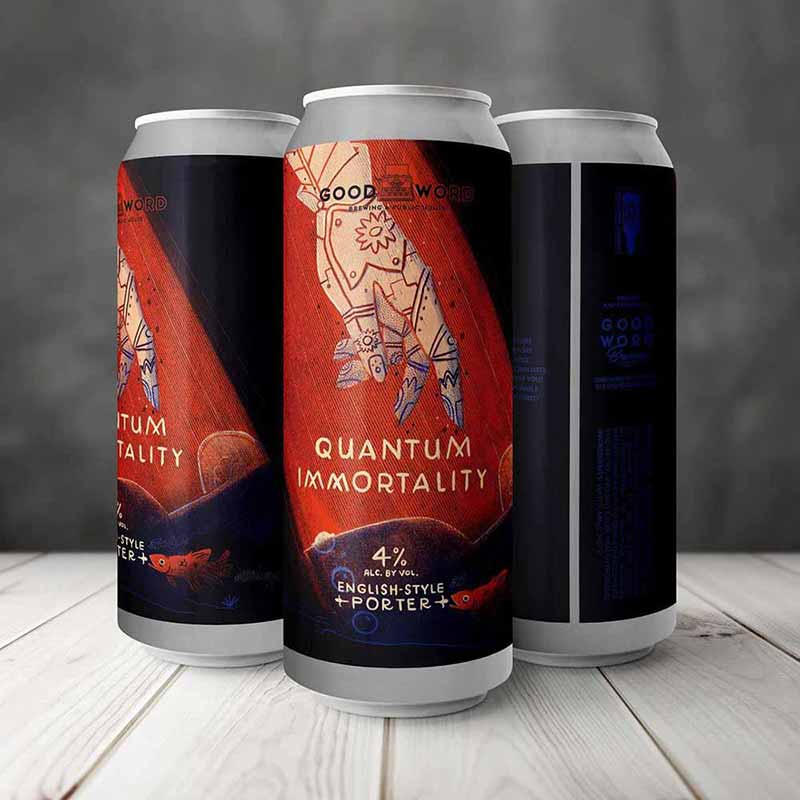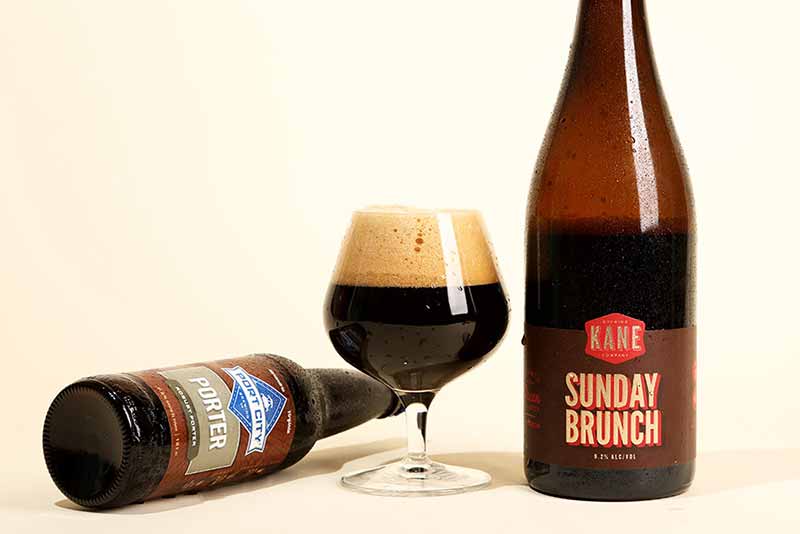
Not all dark beers are sweet, barrel-aged, big-bodied stouts. For instance, the porter—a garnet- to rust-colored beer that’s light, delicious, and worth considering adding to your portfolio.
Why? Whether you’re brewing an English-style, brown, or robust, porters have historically focused on drinkability and approachability. Traditionally, English brewers made the style for the workers to consume because it was a lighter, more approachable brew. Something more and more consumers search for in a beer nowadays, too. And with the weather turning cooler in many parts of the Northern Hemisphere, now is the perfect time to play around with adding a porter to your tap list.
How do you master the balancing act to make a flavorful and wonderfully drinkable porter? We talked to the experts to find out.
We chatted with brewers at Cherry Street Brewing, Great Lakes Brewing, Exhibit ‘A’ Brewing, and Good Word Brewing to get the skinny on ideal grist, top considerations, and insider tips to nail the best version of a porter.
(Above photography courtesy of Exhibit ‘A’ Brewing Company)
Affordable, Industry-Leading Brewery Software
How Do the Experts Describe the Best Porter?

Photography courtesy of John A. Paradiso | Hop Culture
Exhibit ‘A’ Co-Founder and Head Brewer Matthew Steinberg says people commonly misunderstand porters because they are dark. What’s the most desirable aspect of porters in his estimation?
“Drinkability for sure,” he says. “People think [porters] are heavy, full, and not drinkable, but I think the best ones out there are drinkable beers.”
Steinberg says an ideal porter features sweetness but is dry and roasty without being astringent.
Whereas Steinberg hovers somewhere between a brown and a robust porter, Great Lakes Brewmaster Mark Hunger, who has been making the brewery’s porter for decades, looks for more of a robust profile.
“It has to have full character—chocolatey, roasty, coffee elements from the malts as well as the hops to back it up,” he says. “It’s not a thinner-bodied beer. It’s gonna be an experience, not anything light.”
Good Word Brewing Owner and Brewer Todd DiMatteo, who makes a porter called Quantum Immortality that Hop Culture ranked as one of its best beers of 2021, takes an entirely different approach to his porters.
“I’m a fan of lower-gravity beers, so I lean towards ABV first, and the style is sort of secondary, I suppose,” he says. “So any porter that is 5% ABV or sub is what I want to drink. I’m a fan of English porter and lightly smoked ones as well.”
For Cherry Street Brewing Product Developer Nate Schieber, it’s somewhere between what Hunger and Steinberg view as their ideal takes on the porter.
“The best porter is one that is balanced,” he says. It can’t be overly roasty and dry. There has to be balance when combining it with the sweetness of the base grain with plenty of body.”
What Is an Ideal Porter Grist?

Photography courtesy of Great Lakes Brewing Company
“For me, it would look like seventy to seventy-five percent base malt, fifteen to twenty percent crystal or Munich malts, and the rest [five to fifteen percent] are your special dark malts,” Schieber says.
He adds that to get that residual sweetness and “big roast of the dark malt,” he mashes between 149 to 152 degrees Fahrenheit.
Steinberg explains that Exhibit ‘A’ uses two-row, brown malt, chocolate wheat, chocolate barley, dextrin, Vienna malt, golden naked oats, and flaked barley.
“The latter two are about mouthfeel and head retention,” Steinberg says. “Those non-flavor appeal.”
Hunger says they use a two-row base malt in their porter and all their beers. But his focus is beyond just which grains to use.
“You want a good quality ingredient,” he says.
Great Lakes uses around seventy-five percent base malt, a “decent amount” of crystal and chocolate malt, and roasted barley.
“What’s unusual for us is we use a very small amount of roasted barley,” Hunger says, noting he believes crystal malt is more traditional.
DiMatteo, like Hunger, says any quality two-row—like a Maris Otter or Chevalier—will do well in a porter. Beyond that, Good Word incorporates brown malt and several specialty malts.
“Briess makes some excellent specialty malts that can add some depth of flavor, perhaps some chocolate or pale chocolate, and even some black malt,” he says.
He adds that they mash on the higher side so his porters finish a bit fuller.
“We also only mash some of the specialty malts, leaving some to be added in the lauter tun during vorlauf,” he says. “This makes for a smoother beer, in my estimation.”
What Hops Are Best to Balance Out Your Porter?
There’s no need to get super creative here. Porters are malt-forward beers, after all.
“I keep it simple. I use Golding hops for bitterness and a touch for aroma,” DiMatteo says. “I feel late additions to the whirlpool, if done, should be light, and dry hopping this style seems like overkill, but that’s just me.”
He adds, “I’m shooting for balance; I’m not trying to beat the drinker over the head with hops. So everything is added with balance in mind.”
Schieber doesn’t necessarily use one specific hop but has a plan, focusing on the bittering.
“You need enough to make about twenty to twenty-five IBUs,” he says. “Typically, I like to use Noble hops with a low alpha acid content, like Mt. Hood, Northern Brewer, et cetera.”
Steinberg says they run a sixty-minute boil and shoot for twenty-five IBUs on their porter.
“A big surprise in our beer is our hops; we use Chinook,” he says. “I love that hop, and I think it should be in a porter—a really lovely flavor, pretty neutral, it works in the beer.”
Steinberg also notes that it’s crucial to use hops as a balance board so the beer doesn’t come out bitter.
“Any bitters will come from the roast,” he says.
Hunger says they bounce around with their recipe from traditional to atypical in the style. Their porter is close to forty IBUs.
“You get some bitterness from the hops, but the malt plays into it with the roastiness,” he says. “Perceived harshness, bitterness is from the roasted malt, but it’s not too terribly bitter.”
Great Lakes uses Nugget for bittering, Willamette hops partway through the boil, and Cascade hops late in the boil—the latter of which is the non-traditional aspect of the porter.
What ABV Works Best for a Porter?

Photography courtesy of Good Word Brewing & Public House
Depending on the variation you’re shooting to make—English-style, brown, Baltic, or robust porter— the alcohol content can vary. Steinberg likes to split the difference.
“I like mid-fives. They are most delicious from 5.2% to 5.4% ABV,” he says. “Above that, it pulls in too much sweetness for me to prefer.”
Steinberg adds,” Unless I’m trying to do a Baltic, which we’re not doing, that would be around 7% or 8% ABV.”
Schieber is cool with anything from as low as 5% ABV to as high as 7% ABV.
“Anything higher than that is getting into the stout realm,” he says, “and away from beer, you can drink three or four of them and not be overwhelmed.”
DiMatteo considers the time of year it is when thinking about his porters’ alcohol content.
“Are you brewing a porter that’s going to be released in the middle of winter? If so, maybe closer to 6% ABV or even higher makes sense,” he says. “I brew what I like to drink, and even if it’s cold outside, I don’t need a beer with elevated ABV to keep my bones warm.”
Overall, he says he shoots for flavor and drinkability over ABV.
“And for me, that means sub 5% ABV,” he adds. “Flavor doesn’t have a threshold, even though alcohol can add to that; I feel it’s often unnecessary unless it’s called for by style.”
Hunger also prefers a compromising ABV in his porter.
“You don’t want to be light, but it’s a porter; it shouldn’t be super heavy [either],” he says. “We see 6% ABV as middle of the road.”
Top Consideration When Brewing a Porter

Photography courtesy of John A. Paradiso | Hop Culture
Since Hunger has been brewing Great Lakes porter for decades, he has a wealth of knowledge about brewing this style.
“It’s a malt-centric beer. … [So] start with that and get a good balance,” he says. “Then obviously the hops. You want those to be a background, not the main event.”
He adds, “For a porter, number one is the malt. number two is the hop. Third but not that much less important is the yeast. You want a straightforward yeast with this thing because malt and hops overshadow yeast character.”
Steinberg focuses on the water as an essential aspect of the porter.
“Water is important, depending on the brewery’s water. Minerality is important,” he says. “Roastiness brings the pH down, so watch that. Stabilize the mash so you don’t bring the pH too low.”
Apart from water, Steinberg says malt is most vital to a porter.
“It’s an important component for the baseline for the beer,” he adds.
Schieber is thinking along the same lines as Steinberg.
“All good beer starts with good water,” he says. “Secondly is your choice of grain. Balance your base malts and specialty dark malts so that there are layers of flavor, not just dark roasty beer.”
For DiMatteo, the top consideration is more conceptual or intangible.
“Just knowing what you intend to make is important,” he says. “I think porter has a pretty broad spectrum, and for the most part, it’s a forgiving style partly due to consumer education and how some brewers market their beers.”
Expert Tips to Brew the Best Porter

Photography courtesy of Night Shift Brewing
DiMatteo says it all comes down to mashing and sparging for lower ABV beers like Good Word’s porter.
“Smaller beers require a bit of extra attention to keep them in balance,” he says. “If you have the ability, it’s a good idea to mash the base malts and hold the specialty malts until the sparge.”
Hunger says one tip for making a solid porter is honing in your temperatures—especially on smaller-scale operations.
“A lot of these malts, you can pick up astringencies, so you want to be careful about that,” Hunger says. “Brewing on a smaller system with less control, you want to keep an eye on that.”
Steinberg touched on several tips to get the best version of a porter at your facility, including water and educating the consumer about the style. But most of all, it’s about drinkability.
“One thing I feel is consistently brew porter with the intent of being a drinkable, sessionable beer,” he says. “Just because something is dark doesn’t mean it’s going to be heavy or too much flavor.”
Schieber hints at keeping an eye on your pH, especially while using darker malts.
“I was taught a long time ago that when you are brewing with dark malts, pay attention to how those malts affect pH when mashing in and transferring to your kettle,” he says. “You want to add your salts in conjunction with those specialty malts to create buffers and avoid wild pH jumps.”
Four Examples of a Great Porter

Graphic courtesy of Great Lakes Brewing Company
Hunger says the best porter Great Lakes has is the one they’ve been making for decades: Edmund Fitzgerald. On Untappd, the brewery describes the 6% ABV porter as robust and complex with 37 IBUs.
“It just has a lot of character to it,” Hunger says. “It’s a drinkable beer, but it has a lot of character. It’s stood the test of time. And it’s our most awarded beer.”
Good Word Brewing has its 4% ABV English-style porter Quantum Immortality, which DiMatteo feels is the top of all the porters they’ve produced over the years.
“We have brewed a few English porters, brown ales, and smoked porters. All drink great, but Quantum is a house beer for us,” DiMatteo says of the year-round brew. “The low ABV helps to make it approachable. It’s dark, rich, yet not too full-bodied, and exceptional on cask.”
Cherry Street Brewing features a robust porter, That Coconut Porter, so named because of the influx of customers asking if they are the company that “makes that coconut porter, right?” They have been brewing the 6% ABV porter with toasted organic coconut and Moroccan dates for over a decade.
“It’s smooth, creamy, and full-on coconut candy bar flavor,” he says. “This beer is so popular because of its approachability among every type of beer drinker. It’s not too hoppy, sweet, or strong.”
Steinberg says the Briefcase Porter at Exhibit ‘A’ is an excellent representation of the style. The beer is 5.4% ABV and accentuates the roasted malts, for which they worked with a local maltster to get the ideal Lovibond on the grain.
“We dug into the flavor in these grains, and it was appealing and a wonderful experience … such a treat to us to work with the local maltster,” he says. “The grains are freshly roasted, made to order, and made to our intention. I’m most proud of the ingredients and relationships created through this beer.”



